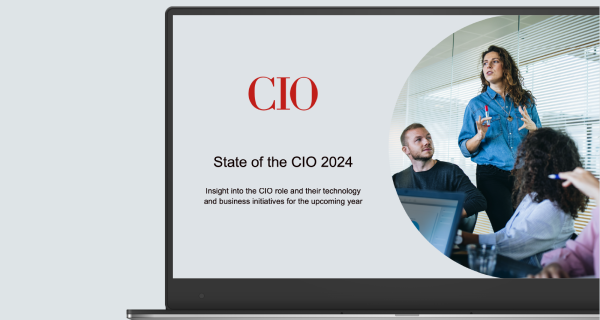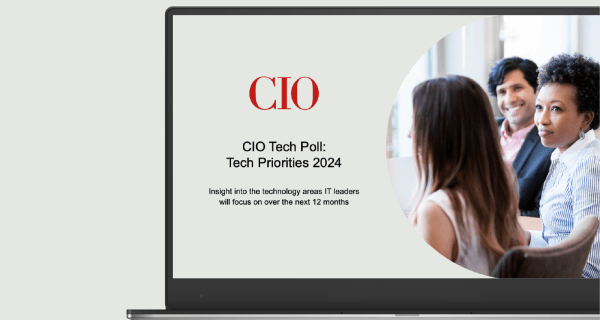Even as CIOs devote time to modernization and optimization, their primary charter is as change makers championing and leading business transformation.
After years of discourse on the CIO’s evolving role, Tim Dickson landed a chance to spring into action. The veteran IT leader jumped from a high-profile CIO post to a newly-created Chief Digital Information (CDIO) role at an industrial equipment manufacturer to practice what is regularly being preached—that CIO responsibilities transcend technology and are as much about driving business transformation.
The new opportunity at Regal Rexnord, a manufacturer of electric motors and power transmission components, allowed Dickson to officially formalize a role he’s played for some time. “In this day and age, a CIO needs to be able to do more than the traditional job description, including leading large transformation efforts,” he says. “This job gave me the opportunity to formally move into a position that demonstrates how the CIO role is changing.”
While modernization and optimization work still tops the CIO agenda, IT leaders are just as busy directing business strategy, prepping the organization for the next wave of innovation fueled by AI, and expanding their remit. In their broader capacity, CIOs are taking oversight of additional functional areas, managing a fresh crop of high-level executive reports, and taking responsibility for new revenue streams.
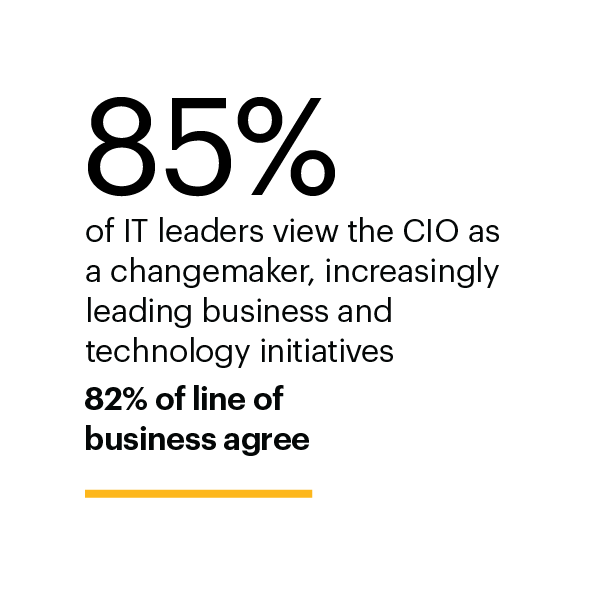
According to the 2024 State of the CIO, which surveyed 875 IT leaders and 251 line of business (LOB) participants, the CIO role is more digital and innovation-focused than ever before, cited by 88% of respondents and up from last year, at 85%. CIOs are now more involved in leading digital transformation initiatives compared to their business counterparts (87%), and 85% of IT leaders surveyed view the CIO role as a changemaker, increasingly taking the lead on business and technology initiatives.
Even more telling—LOB is finally recognizing CIOs’ enhanced status. Seventy-nine percent view CIOs as the primary lead on digital transformation efforts, while 82% regard them as critical changemakers for both business and technology initiatives. Three-quarters of IT leaders and 78% of LOB respondents said the CIO role has been elevated due to increased visibility within the organization—a trend that shows no sign of retrenching.
In fact, the business continues to draw on CIOs to guide both technology and business strategy decisions. This year’s research found almost half (48%) of IT leaders and 41% of LOB respondents look to the CIO to proactively identify business opportunities as well as make technology and provider recommendations. A quarter of CIO and LOB respondents view the CIO role as a consulting advisor, providing input on business needs along with the standard technology and provider recommendations. Sixteen percent of IT leaders and 11% of LOB respondents sought consultation with the CIO because of their ability to advise through a risk management or governance lens.
CIOs are also capitalizing on hard-won efforts to secure their spot in the C-suite corridors. Almost half (48%) of respondents now report directly into the CEO. CIOs are also being awarded oversight of some of the newly established technology-oriented C-level roles: 48% of Chief Data Officers report to the CIO, as do 44% of Chief Digital Officers, 49% of Chief Security Officers and CISOs, and 57% of Chief Analytics Officers. Chief Technology Officers and Chief Innovation Officers were more likely to report into the CEO, at 56% and 57% respectively.

Outside of the expansive CIO leadership capacity, the IT organization itself is becoming more business-driven. IT leader respondents pointed to automating business and IT processes (43%), implementing and creating new AI applications (32%), and making data more available (29%) as ways IT is catering more effectively to business needs, the 2024 State of the CIO research found.
The lines that separate `IT’ and ‘the business’ continue to blur. We’re all members of the same business, striving to achieve the same goals.
Angela Yochem, Global CIO at Krispy Kreme
CIO priorities: A triple balancing act
While CIOs take the lead in directing future business and technology strategy, they remain immersed in the work of optimizing, modernizing, and securing technology infrastructure. This year, 40% of IT leaders’ time is spent on transformational tasks, followed by strategic (35%), and functional (25%). Looking out over the next one to three years, nearly half (49%) of IT leader respondents expect to play more of a strategic role, with 36% anticipating an emphasis on transformational responsibilities and a narrow 14% expecting their dockets to be consumed by functional activities.
Much like last year, the 2024 State of the CIO research found CIOs still caught up in functional duties like security management (50%), improving IT operations and systems performance (41%), and cost control and expense management (31%). Transformational-related tasks also dominated their agenda, with a focus on aligning IT initiatives with business goals (36%), modernizing infrastructure and applications (36%), and leading change efforts (28%). Business strategist work is centered around driving business innovation (31%), developing and refining business strategy (24%), and identifying opportunities for competitive differentiation (18%), the 2024 research found.
This year’s top CEO priorities for the CIO role indicate a swing back towards advancing business strategy to bolster innovation. Twenty-eight percent of respondents said the No. 1 objective voiced by CEO leadership is for CIOs to lead digital business and digital transformation initiatives, up from less than a quarter (23%) last year. Fortifying IT and business collaboration and upgrading IT and data security to reduce corporate risk were next-up on the CEO agenda, according to 27% of respondents.
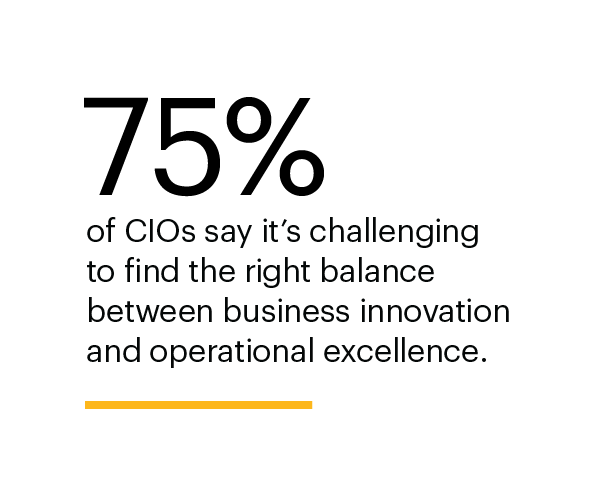
Given the accelerated pace of change and the centrality of technology and digital platforms to every facet of the business, it’s no wonder CIOs continue to walk a fine line balancing all the demands of their ever-expanding remit. Three-quarters of respondents to this year’s survey said it was a challenge to balance the demands for business innovation with operational excellence, in line with last year’s findings.
Deepa Soni, CIO at The Hartford, says the need for IT leaders to be adept at leading and orchestrating functional, strategic, and transformational responsibilities simultaneously won’t change any time soon, regardless of industry shifts or CIOs’ continued ascension in the enterprise. “I see the role as encompassing all three today with the highest focus for me now on strategist work,” says Soni, citing her ongoing efforts to develop new business models and explore how and where the insurance giant can leverage Generative AI for competitive advantage.
Under Soni’s direction, The Hartford’s IT group is defining and implementing digital opportunities designed to deliver a “step-change” in business value as opposed to an incremental return. Yet those innovation activities are happening in tandem with ongoing modernization and will continue to do so for the foreseeable future. “For us, modernization and innovation are not sequential … and without modernization, innovation doesn’t mean much,” she explains. “We spend time collaborating, codesigning, and strategizing with the business to determine how modernization will help business outcomes.”
For us, modernization and innovation are not sequential…and without modernization, innovation doesn’t mean much.
Deepa Soni, CIO at The Hartford
How CIOs are transforming and optimizing the business
As organizations emerge from the post-pandemic period, there remains a significant emphasis on optimizing and transforming business operations. Forty-four percent of IT leaders are anticipating a full docket of initiatives keyed to increasing operational efficiencies, with 43% earmarking projects to transform existing business processes using automation and integration.
Despite some economic uncertainty this last year, IT budgets remain flush. Fifty-four percent of CIOs surveyed for the 2024 State of the CIO anticipate budget increases, while 35% expect IT investments to remain the same. On average, companies report a 17.4% budget increase, a bit higher than the 15% reported in the prior two years. For the 11% expecting IT spending cuts, the average dip was 18.8%.
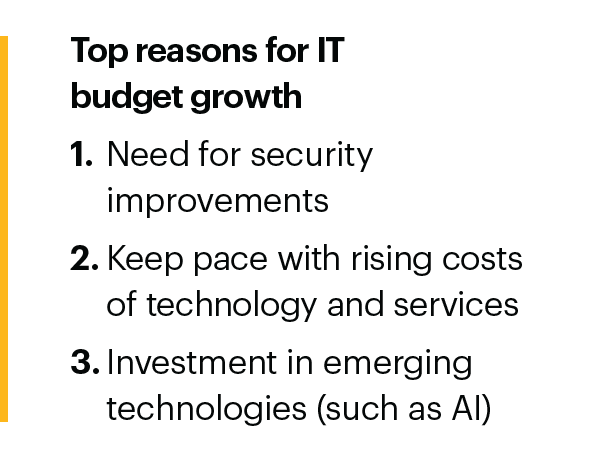
Companies are expanding IT budgets for a variety of reasons. Most cited the need for security improvements (38%) along with having to keep pace with the rising costs of technology and services (35%) and investment in emerging technologies like AI (34%). Those respondents who said their firms were tightening the IT purse strings called out company performance (67%), economic uncertainty (64%), and a reduction in employee headcount (35%) as the primary culprits.
IT budgets are being directed to a number of leading technology areas. Among the more prominent are business process automation and IT automation offerings along with machine learning and AI technologies, all cited by 44% of respondents to the 2024 State of the CIO research. Data/business analytics (38%), application modernization (27%), and infrastructure modernization (23%) are also on the shortlist for technology investment as part of the 2024 IT budget cycle, the research found.

Given the focus on securing and automating operations and parlaying AI technologies for future innovation, CIOs are reprioritizing where and when they get involved. In addition to upping their presence on AI initiatives, IT leaders expect to ramp up participation in efforts tied to cybersecurity (70%), data privacy and compliance (61%), data analysis (54%), and customer experience (51%).
At Casey’s, the third largest convenience store chain in the United States, the last couple of years have been devoted to IT transformation initiatives, including moving from a project to a product mindset to drive digital innovation, according to CIO Sanjeev Satturu. Operating with 2,600 stores in 17 states, the $12 billion chain continues to scale its technology foundation, rationalize legacy systems, and deploy edge infrastructure to support frictionless customer experiences and advanced analytics for data-driven decision-making. It is also actively working to reduce the complexity of Point of Sale (POS) systems to improve transaction speeds to better serve customers hungry for flexibility and convenience.
“The business of convenience requires us to continually transform,” Satturu says. “Modernization is not one-time done. You have to continuously work on modernizing platforms and solutions because with the rate technology moves, everything becomes legacy really quickly.”
As in years past, security remains a top concern and an area of ongoing IT investment. Increasing cybersecurity protections was the No. 1 business initiative this year, cited by almost half of IT leader respondents (49%) compared to only 44% last year. Security and risk management technology is slated for a significant slice of the IT budget, cited by 45% of IT leaders and 20% of LOB respondents.
Upleveling cybersecurity, particularly as it relates to fraud management, remains a top priority at TIAA, according to Upendra Mardikar, CISO for the financial services provider. The firm has a four-pronged strategy to address the continuously changing threat and regulatory landscape: Embrace Zero Trust principles; leverage AI to automate and elevate its defenses against attacks; upskill and reskill cyber talent and make cybersecurity a team sport; and collaborate with consortia and CISO peers to develop security best practices and strategies, he explains.
“We’re seeing exponential growth in the threat landscape, including cyber threats coming from nation-states,” Mardikar says. “We continue to incorporate advanced capabilities and controls, protection and recovery capabilities, and Zero Trust so our platform is trustworthy, safe, and secure for clients and customers.”
“Modernization is not one-time done. You have to continuously work on modernizing platforms and solutions because with the rate technology moves, everything becomes legacy really quickly.”
Sanjeev Satturu, CIO, Casey’s
Infrastructure for innovation: AI takes center stage
This was the year AI and, more recently, generative AI entered the mainstream and cast a hotter spotlight on the strategic nature of the CIO role. CIOs are front and center charting the AI roadmap, from working closely with the business to formulate AI applications and use cases, cited by 71% of 2024 State of the CIO respondents, to researching and evaluating possible AI additions to the technology stack (80%). More than half (58%) of IT leaders said IT and LOB were aligned on the adoption and use of generative AI, in particular.

Over the next year, IT leaders anticipate increased involvement in AI/ML endeavors, cited by 80% of IT leader respondents. Business users also want to see greater CIO involvement in planning and executing AI initiatives. Nearly three-quarters (74%) of LOB respondents to the 2024 State of the CIO research said CIOs are working more closely with them on AI applications, and 77% said IT leaders are spearheading the research of AI solutions to augment the technology stack.
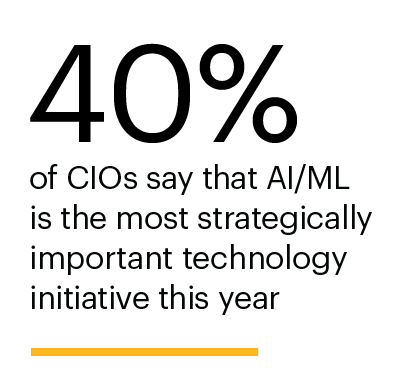
There is mounting desire to capitalize on AI to reimagine the business in new and compelling ways. Almost half (49%) of CIOs and 29% of LOB respondents called out machine learning and AI as the technology initiatives that will be most strategically important this upcoming year. AI is also a top reason for companies to increase their IT budgets, cited by 34% of respondents. Already, AI technologies are being used to reshape data center operations—an evolution cited by 54% of IT leaders and 71% of LOB respondents, according to this year’s research.
While deep into AI deployment at his previous CIO engagement, Regal Rexnord’s Dickson is back at square one, exploring where to apply AI for industrial manufacturing and identifying potential use cases. To that end, Dickson’s team has pinpointed three areas where AI can deliver a competitive edge: For orchestrating more effective production scheduling and planning; for buying the right parts to produce orders for customers; and for demand forecasting.
With the initial game plan established, Regal Rexnord is sailing right along on its AI journey. The company has hired its first data scientist, built a base collection of models, and instituted MLOps (Machine Learning Operations), a set of practices for deploying and operationalizing the AI model lifecycle, Dickson says.
We’re starting from scratch, trying to figure out where AI can move the needle.
Tim Dickson, CIO at Regal Rexnord
Skills for success: Talent challenges loom large
As CIOs struggle to balance optimization and innovation, they face a number of challenges—the biggest being ongoing staffing and skills shortages. Thirty-nine percent of IT leader respondents said dealing with the talent problem caused them to redirect time and energy away from strategic and innovation tasks. Changing business conditions (43%), the need to address security threats (43%), and budgetary constraints, coupled with the ability to demonstrate ROI, were hurdles for 41% of respondents.

On the talent front, organizations are targeting the usual areas to build out their skills pipeline. Ramping up cybersecurity talent is a major priority, cited by 42% of IT leader respondents. Companies are also on the hunt to acquire AI/ML expertise over the next six to 12 months, cited by 39% of respondents, followed up by hires with data science and analytics skills, at 32%.
Because AI/ML expertise is in hot demand, it is also where IT leaders expect to have the most trouble attracting talent. Slightly more than a quarter (27%) expect to have difficulty finding professionals with the appropriate AI/ML skill sets, followed up by cybersecurity (26%), data science/analytics (20%), and enterprise architecture (17%).
As CIOs reach for the mantle of leading business strategy and transformation, they need to do so prepared to balance the growth agenda with continuous IT optimization and modernization. “You don’t get to drive digital transformation with the ship running smoothly,” Dickson says.
About the 2024 State of the CIO study
The 23rd annual State of the CIO survey was fielded online with the objective of understanding the current parameters of the CIO role and how it may be changing over time. To be considered qualified, respondents must have identified themselves as the head of IT for their company or a division within it. Results are based on 875 qualified IT respondents and 251 LOB responses. This study was fielded globally, with the response base being 41% North America, 19% EMEA, and 38% APAC.





